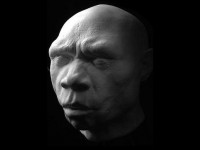DAN PETROVIC
Faces of Human Ancestors
source: newsdiscovery
Homo heidelbergensis
This adult male, Homo heidelbergensis, was discovered in in Sima de los Huesos, Spain in 1993. Judging by the skull and cranium, scientists believe he probably died from a massive infection that caused a facial deformation. The model, shown here, does not include the deformity. This species is believed to be an ancestor of Neanderthals, as seen in the shape of his face. “Miquelon,” the nickname of “Atapuerca 5”, lived about 500,000 to 350,000 years ago and fossils of this species have been found in Italy, France and Greece.
.
.
.
.
.
.
.
source: dailymailcouk
A mysterious species of ancient human has been discovered in a cave in southern Siberia.
Nicknamed X-Woman, scientists say the human lived alongside our ancestors tens of thousands of years ago.
The discovery, which could rewrite mankind’s family tree, was made after analysis of DNA from a fossilised finger bone.
Experts believe the finger belonged to a child who died 48,000 to 30,000 years ago.
It was thought only two species of early humans lived at that time – the ancestors of modern man and the Neanderthals, who died out soon afterwards.
But the DNA evidence published in the journal Nature reveals a third species.
The latest study was based on an analysis of ‘mitochondrial’ DNA – a genetic code passed from mothers to children.
Researcher Dr Svante Pääbo said the code was different from that of Neanderthals and modern humans and was ‘a new creature that’s not been on our radar screens so far’.
The scientists are unable to say what X-Woman looked like and are even unsure if the finger belonged to a male of female, but Dr Pääbo said they named her X-Woman ‘because its mitochondrial and we want to take a feminist tack on this’.
The discovery of the ‘X-Woman’ comes as scientists revealed images of what man looked like millions of years ago.
Gathering bone fragments from across the globe, paleoanthropologists used sophisticated research methods to form the 27 model heads, which are on show at the Senckenberg Natural History Museum in Frankfurt, Germany.
The exhibition goes back seven million years to sahelanthropus tchadensis and traces the numerous stages of man culminating with modern-day homo sapiens.
Each of the heads is used to tell its story: where they lived; what they ate; and what killed them.
It shows how researchers today use satellite image analysis and computer tomography.
There is little doubt that Africa is the cradle of humanity and this is where the most ancient of the remains were unearthed. But clues to other pre-human species have been found in the Middle East and Far East.
Only a few thousand fossils of pre-human species have ever been discovered and entire sub-species are sometimes known only from a single jaw or fragmentary skull.
Experts are often forced to resort to educated guesswork to fill in the gaps in research to come up with images of human ancestors.
Each new discovery means paleoanthropologists have to rethink the origins of man’s ancestors.
The previously held concept of primitive man – characterised by a large brain and the ability to manufacture tools – has had to be changed by researchers.
European natives of primitive man, homo heidelbergensis, are believed to have been able to make perfect javelins from wood 400,000 years ago and are also thought to have had the ability to plan for the future.
Neanderthals are also now thought to have had far more culture and craft skills than earlier research indicated.
.
.
.
.
.
.
.
source:
Para colocar um rosto em nossos ancestrais, os cientistas do Instituto de Pesquisa Senckenberg utilizaram métodos sofisticados para formar 27 cabeças baseadas em minúsculos fragmentos de ossos, dentes e crânios coletados em todo o globo. As cabeças estão em exibição pela primeira vez juntas no Museu de História Natural Senckenberg, em Frankfurt, Alemanha.
Homo heidelbergensis
O macho adulto do Homo heidelbergensis, foi descoberto em Sima de los Huesos, Espanha, em 1993. A julgar pela analise do crânio, os cientistas acreditam que ele provavelmente morreu de uma infecção generalizada que causou uma deformação facial. O modelo, mostrado aqui, não inclui a deformidade. Acredita-se que esta espécie é um ancestral do homem de Neandertal, como visto na forma de seu rosto.Ele viveu há cerca de 500.000 a 350.000 anos atrás e os fósseis desta espécie foram encontrados na Itália, França e Grécia.
.
.
.
.
.
.
.
.
source: realitateanet
Craniile au fost redate publicului pentru prima oară într-o expoziţie organizată în Germania, la Muzeul de Istorie Naturală Senckenberg, din Frankfurt, scrie Discovery News.
Acest bărbat adult a fost descoperit în Sima de los Huesos, Spania, în 1993. Judecând după craniu, oamenii de ştiinţă cred că a murit în urma unei infecţii masive, care i-a cauzat deformarea feţei. Modelul de faţă nu arată deformarea.
Se crede că această specie este un strămoş al neanderthalienilor. Miquelon, porecla lui Atapuerca 5, a trăit în urmă cu 500.000 până la 350.000 de ani. Fosilele acestei specii au fost descoperite în Italia, Franţa şi Grecia.


